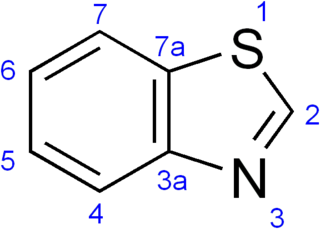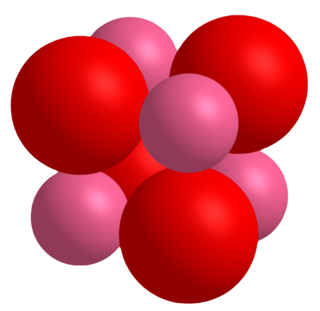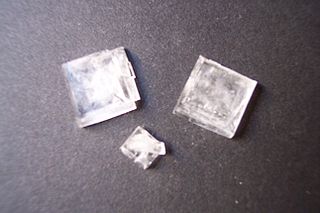
Microcline (KAlSi3O8) is an important igneous rock-forming tectosilicate mineral. It is a potassium-rich alkali feldspar. Microcline typically contains minor amounts of sodium. It is common in granite and pegmatites. Microcline forms during slow cooling of orthoclase; it is more stable at lower temperatures than orthoclase. Sanidine is a polymorph of alkali feldspar stable at yet higher temperature. Microcline may be clear, white, pale-yellow, brick-red, or green; it is generally characterized by cross-hatch twinning that forms as a result of the transformation of monoclinic orthoclase into triclinic microcline.

Phosphoric acid is a weak acid with the chemical formula H
3PO
4. The pure compound is a colorless solid.

Calcium peroxide or calcium dioxide is the inorganic compound with the formula CaO2. It is the peroxide (O22−) salt of Ca2+. Commercial samples can be yellowish, but the pure compound is white. It is almost insoluble in water.

Fumaric acid is an organic compound with the formula HO2CCH=CHCO2H. A white solid, fumaric acid occurs widely in nature. It has a fruit-like taste and has been used as a food additive. Its E number is E297. The salts and esters are known as fumarates. Fumarate can also refer to the C
4H
2O2−
4 ion (in solution). Fumaric acid is the trans isomer of butenedioic acid, while maleic acid is the cis isomer.

Methylcyclopentadienyl manganese tricarbonyl (MMT or MCMT) is an organomanganese compound with the formula (C5H4CH3)Mn(CO)3. Initially marketed as a supplement for use in leaded gasoline, MMT was later used in unleaded gasoline to increase the octane rating. Following the implementation of the Clean Air Act (United States) (CAA) in 1970, MMT continued to be used alongside tetraethyl lead (TEL) in the US as leaded gasoline was phased out (prior to TEL finally being banned from US gasoline in 1995), and was also used in unleaded gasoline until 1977. Ethyl Corporation obtained a waiver from the U.S. EPA (Environmental Protection Agency) in 1995, which allows the use of MMT in US unleaded gasoline (not including reformulated gasoline) at a treat rate equivalent to 8.3 mg Mn/L (manganese per liter).

Ethylparaben (ethyl para-hydroxybenzoate) is the ethyl ester of p-hydroxybenzoic acid. Its formula is HO-C6H4-CO-O-CH2CH3. It is a member of the class of compounds known as parabens.

Benzothiazole is an aromatic heterocyclic compound with the chemical formula C
7H
5NS. It is colorless, slightly viscous liquid. Although the parent compound, benzothiazole is not widely used, many of its derivatives are found in commercial products or in nature. Firefly luciferin can be considered a derivative of benzothiazole.

Stigmasterol – a plant sterol (phytosterol) – is among the most abundant of plant sterols, having a major function to maintain the structure and physiology of cell membranes. In the European Union, it is a food additive listed with E number E499, and may be used in food manufacturing to increase the phytosterol content, potentially lowering the levels of LDL cholesterol.

Menadione is a natural organic compound with the formula C6H4(CO)2C2H(CH3). It is an analog of 1,4-naphthoquinone with a methyl group in the 2-position. It is sometimes called vitamin K3. Use is allowed as a nutritional supplement in animal feed because of its vitamin K activity.

Zinc dialkyldithiophosphates are a family of coordination compounds developed in the 1940s that feature zinc bound to the anion of a dialkyldithiophosphoric acid. These uncharged compounds are not salts. They are soluble in nonpolar solvents, and the longer-chain derivatives easily dissolve in mineral and synthetic oils used as lubricants. They come under CAS number 68649-42-3. In aftermarket oil additives, the percentage of ZDDP ranges approximately between 2 and 15%. Zinc dithiophosphates have many names, including ZDDP, ZnDTP, and ZDP.

2-Methoxyethanol, or methyl cellosolve, is an organic compound with formula C
3H
8O
2 that is used mainly as a solvent. It is a clear, colorless liquid with an ether-like odor. It is in a class of solvents known as glycol ethers which are notable for their ability to dissolve a variety of different types of chemical compounds and for their miscibility with water and other solvents. It can be formed by the nucleophilic attack of methanol on protonated ethylene oxide followed by proton transfer:

Cobalt(II) oxide is an inorganic compound that has been described as an olive-green or gray solid. It is used extensively in the ceramics industry as an additive to create blue colored glazes and enamels as well as in the chemical industry for producing cobalt(II) salts. A related material is cobalt(II,III) oxide, a black solid with the formula Co3O4.

Dipotassium phosphate (K2HPO4) (also dipotassium hydrogen orthophosphate; potassium phosphate dibasic) is the inorganic compound with the formula K2HPO4.(H2O)x (x = 0, 3, 6). Together with monopotassium phosphate (KH2PO4.(H2O)x), it is often used as a fertilizer, food additive, and buffering agent. It is a white or colorless solid that is soluble in water.
Ammonium malate refers to organic compounds containing malate and ammonium. Two stoichiometries are discussed: NH4(C2H3(OH(CO2)2H, containing one ammonium ion per formula unit, and (NH4)2(C2H3(OH(CO2)2. Malate, the conjugate base of malic acid, is chiral. Consequently a variety of salts are possible, R vs S vs racemic. The monoammonium salt has been crystallized as the monohydrate.

Ferrous lactate, or iron(II) lactate, is chemical compound with idealized formula Fe(C3H5O3)(H2O)n. No compound has been characterized to establish composition, purity, or structure.
Nomenclature of Inorganic Chemistry, IUPAC Recommendations 2005 is the 2005 version of Nomenclature of Inorganic Chemistry. It is a collection of rules for naming inorganic compounds, as recommended by the International Union of Pure and Applied Chemistry (IUPAC).

Manganese(II) oxide is an inorganic compound with chemical formula MnO. It forms green crystals. The compound is produced on a large scale as a component of fertilizers and food additives.

4-Methylcyclohexanemethanol (MCHM, systematic name 4-methylcyclohexylmethanol) is an organic compound with the formula CH3C6H10CH2OH. Classified as a saturated higher alicyclic primary alcohol. Both cis and trans isomers exist, depending on the relative positions of the methyl (CH3) and hydroxymethyl (CH2OH) groups on the cyclohexane ring. Commercial samples of MCHM consists of a mixture of these isomers as well as other components that vary with the supplier.

Triammonium citrate is a chemical compound whose molecular formula is C6H17N3O7.























